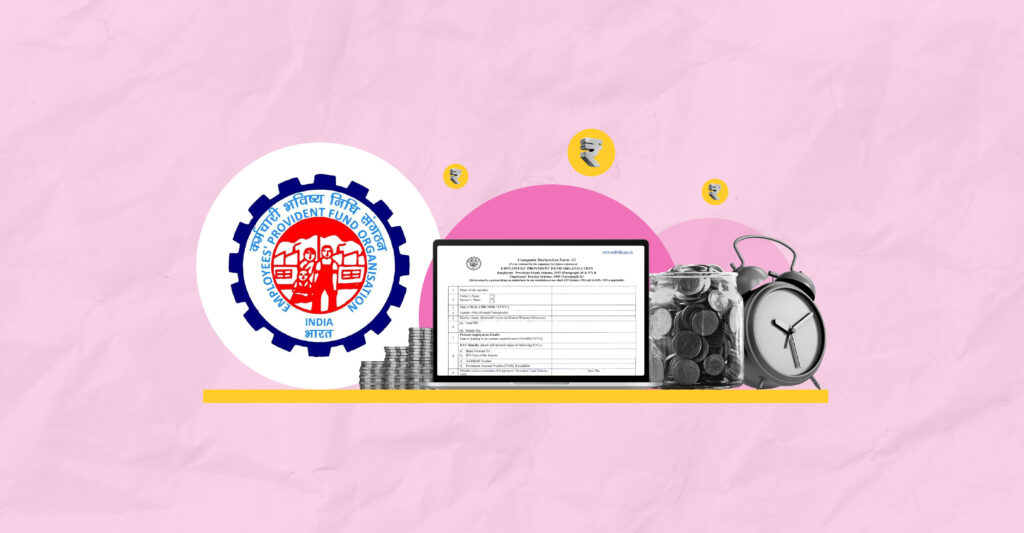Last Updated on Jul 19, 2022 by
The Employee Provident Fund (EPF) is one of the saving schemes launched by the Government of India. In this scheme, the employee and the employer will contribute a small amount every month, which the employee can avail at retirement or during any financial emergency.
An employer with more than 20 employees must register the employees with more than Rs. 15,000 salary per month in the EPF scheme. If you are an existing EPF account holder and are joining a new organisation, then your EPF account details will be transferred from your old employer to the new one. In this case, you must provide the new employer with a duly filled EPF form 11, allowing them to contribute to the Provident Fund (PF) account. In this article, let’s discuss EPF Form 11 in detail with the employer’s responsibilities.
Table of Contents
What is EPF Form 11?
EPF Form 11 is a self-declaration form the employee must fill out and submit while joining a new organisation registered under the EPF Scheme of 1952. The form will have all the PF information related to an employee. The purpose of this form is as follows:
- If you are a new employee and an existing member of the EPF scheme, you will continue to get the scheme’s benefits but under a new Member ID.
- Suppose you were not a member of EPFO (Employees’ Provident Fund Organisation) during the past employment or were not employed before, and your salary is more than Rs. 15,000 per month in the new employment. In that case, you can opt-out of the EPF scheme. Such employees are known as Excluded Employees. Members who have withdrawn PF before the tenure are also considered excluded employees.
- Form 11 is also used to automatically transfer the PF amount from the previous account to a new one.
- The form also helps the Provident Fund Department to maintain the updated details of employees, which will help them during audits, verification or inspections.
Fields on the EPF Form 11
The EPF Form 11 is available online to download at https://www.epfindia.gov.in/. The fields on the form are as follows:
- Name of the employee
- Date of birth of the employee
- Father’s/Spouse’s name
- Gender
- Email id
- Mobile number
- Relationship of the employee with EPS and EPF schemes
- Previous employment details such as the UAN, last working day, scheme certificate number
- Educational details
- Marital status
- KYC details, including bank account number, driving licence, etc.
- Passport (in case of foreign employees)
Additionally, the employer needs to provide the following details for declaration:
- Employee’s date of joining
- Provident Fund ID number assigned to the employee
- UAN of the employee
- Verification of the employee’s details
How to fill out the EPF Form 11?
The first half of the EPF Form 11 is about the personal details of the employee as follows:
- Name
- Father or spouse’s name
- Date of birth
- Gender
- Marital status
- Email id and mobile number
Once you fill in the personal details, the second half of the form is about the previous employer and EPF or EPS (Employee’s Pension Scheme) as follows.
- Whether earlier a member of Employees Provident Fund Scheme, 1952
- Whether earlier a member of Employee’s Pension Scheme, 1995
If you have marked “YES” for any of the questions asked above, you must fill in the details below:
- Universal Account Number (UAN)
- Previous PF account number
- Date of exit from previous employment in the format dd/mm/yyyy
- Scheme certificate no. (if issued)
- Pension Payment Order (PPO) No. if issued
After filling in these details, you need to provide the KYC details (bank account number, IFSC, Aadhaar number, Permanent Account Number (PAN)), which should be self-attested.
EPF Form 11 for international workers
The term “International Workers” applies to the following sets of individuals:
- If you are not an Indian but working in India with a company covered under the Employees’ Provident Funds & Miscellaneous Provisions Act, 1952.
- If you are an Indian currently working or have worked in another country with whom India has signed an agreement with respect to Social Security benefits known as Social Security Agreement (SSA).
If you are an international worker who belongs to one of the categories mentioned above, then you need to additionally fill the “International Workers” section of the EPF Form 11, which includes:
- Country of origin
- Passport number
- Validity of passport
Responsibilities of the employer
Once an employee fills the form with the required information, they need to submit it to the employer, who will complete the form with the necessary details from their end before submitting it at the regional EPF office. The responsibilities of an employer regarding the EPF Form 11 are as follows:
- The employer should get the EPF Form 11 filled by the new employees within one month of joining and upload the data in the UAN portal within 25 days from the end of every month.
- The employer should share the UAN details with the existing members within 15 days of the receipt.
- The employer should ensure that the activation of UAN is completed within 15 days of collecting the information.
- The employer should seed the KYC details (PAN, Aadhaar and bank account details) of the EPF members in a month from the date of the UAN receipt generated.
- If the members do not have an Aadhar card, the employer should submit the Aadhaar Acknowledgement Slip within a month from the date of the UAN receipt generated.
- Once the employer gets the Aadhar details from the employee, they must submit it on the UAN portal within 15 days of receiving the information.
- The employer should ensure that the relevant KYC details are linked with the UAN before sending a claim form to the EPFO.
FAQs
1. Should the employee fill out two EPF forms for the new and old employer?
No. The employee need not fill EPF Form no. 11 while with the old employer. Only while joining a new organisation you should fill out the form to provide your EPF details to the new employer.
2. Is it mandatory to fill out the EPF form for the employees?
Any employee whose salary is more than Rs. 15,000 per month and who has been an EPF contributor earlier should fill the EPF Form 11.
3. Can I continue using the same EPF account when joining a new organisation?
While shifting from one company to another, you’ll get a new EPF account under the same UAN. Therefore you cannot continue using the same old EPF account during the job change.
4. Can I hold more than one EPF account at the same time?
No. An employee can have only one EPF account at a particular time. The employer will provide an EPF account monthly to contribute to the pension scheme.
5. What is the process of EPF Form 11 online submission?
The EPF Form 11 filled by the employee will be further filled by the employer and submitted on the UAN portal.
- Best Passive Mutual Funds in India: Top Index Options for 2025 - Mar 28, 2025
- Best Short-Term Mutual Funds in India for 2025 - Mar 28, 2025
- List of Top Small Cap Funds India for 2025 - Mar 27, 2025




